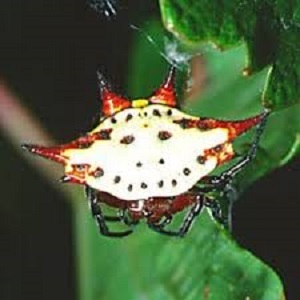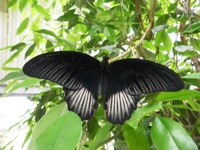
Bark Spiders

 Common Bark Spider (Caer sexcuspidata)
Common Bark Spider (Caer sexcuspidata)
This is a nocturnal orb-web spider occuring throughout South Africa and on islands off the East coast of Africa.
The female constructs a large orb-web, about 1.5m across between trees and shrubs. Its dorsal surface is cryptically coloured, with horny projections which help its camoflage. Ventally it is variable, sometimes with distinct white spots. The legs below are reddish-brown and clearly zebra-striped when viewed from beneath.
During daylight hours she dismantles her web, and retires to a nearby branch, tucking her legs against her body to resemble a part of a branch.
Though mainly nocturnal, it may be found in its web in shady forested areas.
It is the only one of three that occur in Leisure Bay.
Fishing Spider
 One of the fishing spiders. Most of these spiders actually catch fish! These little ones are quite happy to feast on mosquito larvae and tadpoles.
One of the fishing spiders. Most of these spiders actually catch fish! These little ones are quite happy to feast on mosquito larvae and tadpoles.
They are totally harmless to man. (Excepting to sensitive people)
They are often found on still water, with their feet resting on the water surface feeling for movement. The moment they feel motion, they jump into action and catch their meal! Very attractive creatures!
Garden Orb Spider

Garden orb web spider. A large spider that spins a web so that it can detect prey using the radials from it's web. Very attractive guys, and also very interesting to watch. Takes many hours, though, but very interesting to see her finding her prey. These are the spiders whose webs you walk into in your garden or in the forest. I have walked into many of their webs and have never been bitten - they tend to run away, using what web is left to escape.
 A somewhat more attractive orb spider, the Golden Orb web spider. If seen in the right light, the web glows a beautiful golden colour.
A somewhat more attractive orb spider, the Golden Orb web spider. If seen in the right light, the web glows a beautiful golden colour.

They have poor eyesight and rely on the vibrations of the web to find their prey.
Kite Spiders

 Little gems. Two of the more common orb web spiders. Once again they come in a range of exciting colours and shapes to suit every need!
Little gems. Two of the more common orb web spiders. Once again they come in a range of exciting colours and shapes to suit every need!
The webs are another common trap for unwary walkers. I always feel guilty when I walk into these immaculate webs.
Unlike some orb weavers, these spiders are active during the day and do not remove their webs.
The female (the pretty one) measures about 5-8mm and the male 3-4mm.Both of these in the pics occur in our area.
Spittle Bug

The foam is produced from saps from the trees and has an acrid taste.
There are multiple species of these bugs.They are regarded as nuisances but they do not cause any permanent damage. Next time you walk in the forest and think it is raining........

Tailless Whip Scorpion
 This unfortunately dangerous looking insect is in fact totally harmless. It is neither a spider or a scorpion but a bit of both. It has no poison glands and relies on it's pedipalps, which are similar to those of a preying mantis, to catch its prey.
This unfortunately dangerous looking insect is in fact totally harmless. It is neither a spider or a scorpion but a bit of both. It has no poison glands and relies on it's pedipalps, which are similar to those of a preying mantis, to catch its prey.
They flatten themselves so that they can fit into the most narrow of spaces. I found one under my wheel once and it seemed totally unharmed.
They only use six of their eight legs to walk, using the front two as feelers.
Flower Mantis
 Flower mantises are mantises that mimic a flower that attracts their prey. They vary from area to area and country to country, but their behaviour remains the same - climbing a flowering plant and sitting for hours waiting for lunch. There are orchid mantises that mimic orchards so closely that even experts think they are orchards. So next time you touch a flower and it moves, you know that it is probably a mantis.
Flower mantises are mantises that mimic a flower that attracts their prey. They vary from area to area and country to country, but their behaviour remains the same - climbing a flowering plant and sitting for hours waiting for lunch. There are orchid mantises that mimic orchards so closely that even experts think they are orchards. So next time you touch a flower and it moves, you know that it is probably a mantis.
They also use their camoflage to protect themselves from predators.
They include a large number of species, not all occuring in South Africa, but our tree walkers have come accross a substantial number of these beauties.
Crab Spiders
 Among the family of crab spiders (Thomisidae) are the well known flower dwellers. They behave similarly to the flower mantis, adapting themselves to the colour of a flower and awaiting prey attracted by that flower. They do not spin webs and hide beneath vegetation and ground debris when not active.
Among the family of crab spiders (Thomisidae) are the well known flower dwellers. They behave similarly to the flower mantis, adapting themselves to the colour of a flower and awaiting prey attracted by that flower. They do not spin webs and hide beneath vegetation and ground debris when not active.

They have lost their agility and have become semi-sedentary to excell as ambushers.
They are mainly active during the day and move sideways like a crab. Spot the spider.
Dragon Flies

They are predators, both in their aquatic larval stage (nymphs), and as adults.
The adults are on the wing for just a few days or weeks. Several years of their lives are spent in fresh water as nymphs.
They migrate across oceans and are mostly found around water.
Loss of wetland habitat threatens their populations worldwide.
Damselflies
 Damselflies are usually slender and sluggish in flight. The fore and hind wings are usually the same length and are folded over their body when at rest. Unlike dragonflies, whose eyes are close together, damselflies' eyes are spaced well apart.
Damselflies are usually slender and sluggish in flight. The fore and hind wings are usually the same length and are folded over their body when at rest. Unlike dragonflies, whose eyes are close together, damselflies' eyes are spaced well apart.
The males are more brightly coloured than the females. The tip of the tail is usually quite bright, almost glowing.
Their behaviour and life cycle is similar to that of the dragon fly.
They are both quite common in Leisure Bay due to the fact that we maintain our wetlands.
Fire Flies
 They are a family of insects in the order of Coleoptera. They are winged beetles that use bioluminescence to attract mates or prey. They produce light that has no infrared or ultraviolet frequencies. This luminescence produced in the lower abdomen may be yellow, green or pale red. In Leisure Bay they tend to give off a green light. Not too many places left to see them in South Africa!
They are a family of insects in the order of Coleoptera. They are winged beetles that use bioluminescence to attract mates or prey. They produce light that has no infrared or ultraviolet frequencies. This luminescence produced in the lower abdomen may be yellow, green or pale red. In Leisure Bay they tend to give off a green light. Not too many places left to see them in South Africa!
There are about 2100 species of fireflies in the tropic and temperate climates.
Their presence here are as a result of Leisure Bay being almost entirely on vlei, and of course, the wetlands.
All of these creatures are an indication of a well-managed ecological system. The excessive use of pesticides will destroy this fine balance. VISIT OUR FIRE FLY SANCTUARY ON PETER PAN BEACH CAR PARK AND SEE THEM FOR YOURSELVES!
 This beetle is related to the stinkbug family. It is probably a stinkbug nymph. I have looked everywher for more information. Unfortunately I do not have books on beetles, so please can somebody come to the rescue.
This beetle is related to the stinkbug family. It is probably a stinkbug nymph. I have looked everywher for more information. Unfortunately I do not have books on beetles, so please can somebody come to the rescue.
| Back | Back to top |

